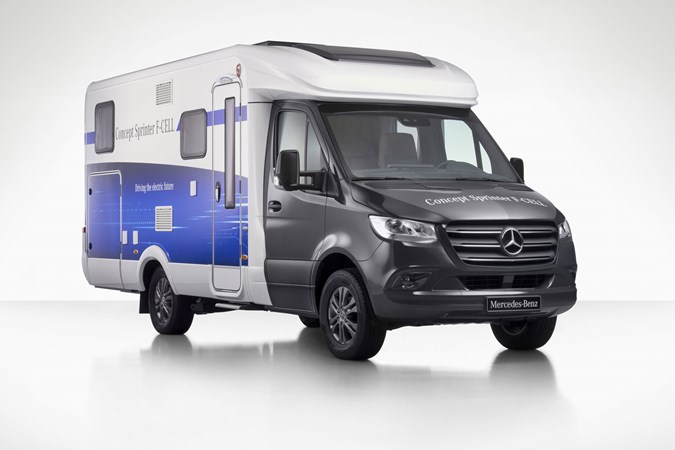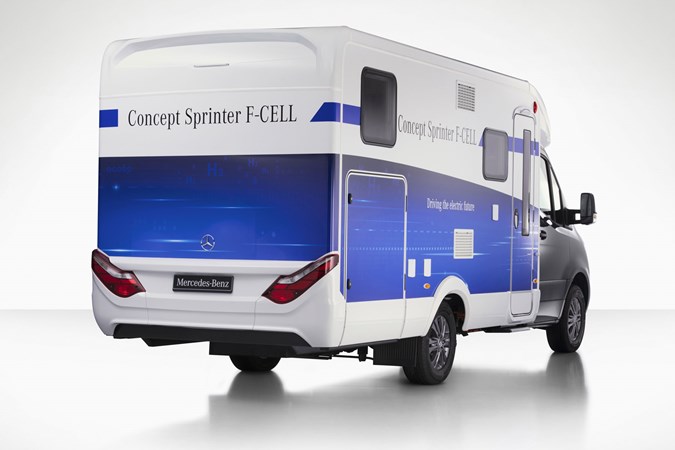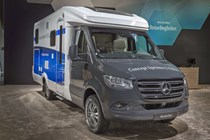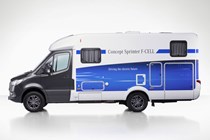Mercedes-Benz is showing a hydrogen fuel-cell powered campervan called Concept Sprinter F-Cell at the 2018 Caravan Salon in Dusseldorf
Based on the latest Mercedes Sprinter, the German firm claims the F-Cell camper is capable of emissions-free, near-silent driving and a range of up to 330 miles between trips to a filling station.
Mercedes F-Cell: modular hydrogen tech made to be flexible
Developed using technology from the GLC F-Cell SUV, which was unveiled to the public at the Frankfurt motor show in 2017, this campervan has a power output of 201hp and an associated torque figure of 350Nm.
It’s actually a plug-in electric powertrain, but instead of using a petrol or diesel engine to provide extra power, this comes from a hydrogen fuel cell. It’s also a fully modular approach, meaning the parts are built to fit into existing Mercedes models – the fuel cell ‘stack’ that generates the electricity sits in the space usually occupied by a conventional engine.
Mercedes long-range hydrogen camper van
As standard there are three high-pressure tanks in the mid-part of the chassis that hold the hydrogen – the most abundant element in the universe – in the underbody of the Sprinter, and these hold 4.5kg of the compressed gas at 700 bar of pressure.
Should more range be required, an additional tank can be installed in the rear to increase the range by a further 120 miles. It’ll take between three and five minutes to fill up at a high-pressure hydrogen filling station.

A battery is also on-board, capable of storing another claimed 19 miles of range, adding up to the 330-mile maximum figure Mercedes is quoting.
The firm also claims developments in the camper’s comfort, because the fuel cell can also be used to power items that usually require plugging your rig into the mains, such as heating, air-con or a fridge. It runs silently, so you’ll be minimising your impact on the local wildlife too, apparently.
The downsides…
Of course, the battery uses lithium, which is a far less desirable environmental message given the difficulties in recycling it. And then there’s the fact we’re currently missing a crucial part of the puzzle – the hydrogen filling infrastructure.
This is developing slowly, but alliances between large car companies and fuel firms (the largest being the H2 Alliance that Mercedes-Benz along with Hyundai and Toyota are part of) are trying to accelerate the roll-out of these facilities.

At time of publication there aren’t many at all – fewer than 30 in the UK – but by the end of next year Mercedes hopes there will be 100 in Germany alone. If you think that sounds like quite a feat, then how about this: the firm’s people told us they’re expecting 10 times that amount by 2023.
When can I buy a Sprinter F-Cell?
Given the previous paragraphs about infrastructure, it won’t come as a huge surprise to learn that Mercedes won’t yet be drawn on when a market-ready hydrogen light commercial vehicle or campervan might go on sale.
It’s dependant on the network of filling stations growing large enough for sales to be profitable in the long-run. Don’t expect to see one over the next couple of years, then…
Also read:
>> Volkswagen Grand California campervan based on VW Crafter – full details
>> Mercedes X-Class camper and kitchen conversions revealed
>> Mercedes Sprinter (2018-on) full review
Just so you know, we may receive a commission or other compensation from the links on this website - read why you should trust us.










